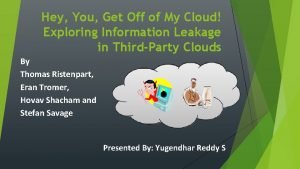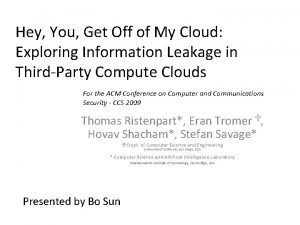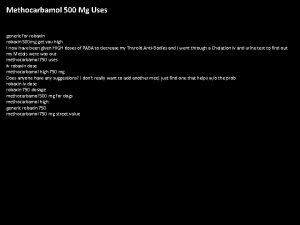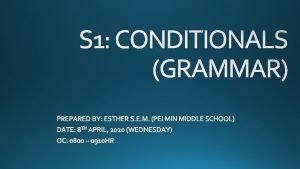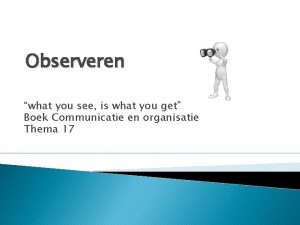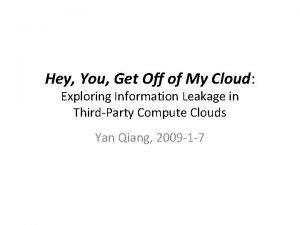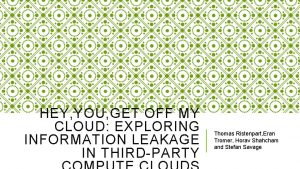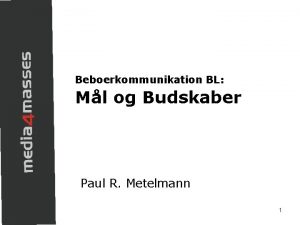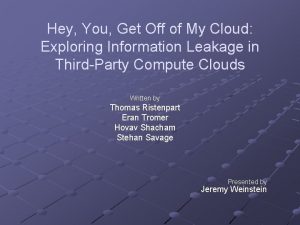Hey You Get Off of My Cloud Exploring




























- Slides: 28

“Hey, You, Get Off of My Cloud: Exploring Information Leakage in Third-Party Compute Clouds” Written by : Thomas Ristenpart, Eran Tromer, Hovav Shacham, Stefan Savage Presented by: Ibrahim Elsayed

Overview ● ● What is the cloud? New threats in cloud computing Research questions Experiment ○ Explore cloud infrastructure. ○ Determine co-residency. ○ Achieve co-residency. ○ Exploit information. ● What can we do? ● Conclusion

Cloud Computing ● What is the cloud? The new infrastructure for hosting data and deploying software and services. ● Benefits ○ Cost Savings ○ Scalability ○ Flexibility

Cloud Computing ● On-demand computing outsourcing ● Examples: ○ Amazon’s EC 2 (Elastic Compute Cloud) ○ Microsoft’s Azure Service Platform ○ Rackspace’s Mosso ● New Threats: ○ Trust relationship between customer and cloud provider ○ Multi-tenancy (security threat)

Multi-tenancy ● Your instance is placed on the same server with other customers

Research Motivation ● Explore threats of multi-tenancy in cloud computing ● Provide experimental results of the impact of these threats using a real cloud service provider (Amazon EC 2) as a case study

Research Questions ● Can one determine where in the cloud infrastructure an instance is located? ● Can one easily determine if two instances are co-resident on the same physical machine? ● Can an adversary launch instances that will be co-resident with other user’s instances? ● Can an adversary exploit cross-VM information leakage once co-resident?

AMAZON ELASTIC COMPUTE CLOUD - EC 2 ● Scalable, pay-as-you-go compute capacity in the cloud ● Customers can run different operating systems within a virtual machine ● Different regions and availability zones

Attack ● The attack considered requires two main steps: 1 - Placement Place a malicious VM on the same physical machine as that of the victim 2 - Extraction extract confidential information from the victim via a side channel attack

Attacker ● Not affiliated with the provider (third-party user) ● Can run many instances at the same time o Can create multiple accounts o Up to 20 instances per account

Cloud Cartography ● Try to learn about how Amazon places instance in order to carry out the attack ● Each instance assigned internal and external IP address ● Review addresses assigned to a large number of launched instances

Determining Co-Residence ● Co-resident: instances running on same machine ● Network-based co-residence checks: ○ Matching (host domain) Dom 0 IP address ○ Small packet round-trip times ■ 10 RTTs ■ 1 st always slow ■ Use last 9 ○ Numerically close internal IP address (within 7)

Achieving co-residency ● Two main techniques are presented to become coresident with another user: - Brute Force launch many instances over a relatively long period of time. - Abusing Placement Locality Target recently launched attacks.

Brute-Force Placement ● Launch many instances within a time frame ○ If co-resident, successful placement ○ Else, terminate probe instance ● Of 1686 target victims co-residence achieved with 141 victim servers ( 8. 4% coverage of targets). ● Max 20 simultaneous instance for one account. ● Allows reasonable success rate when used to target large target sets

Placement Locality ● Recall that one of the main features of cloud computing is to only run servers when needed. ● This suggests that servers are often run on instances, terminated when not needed, and later run again. ● The key idea is to catch the time at which the victim turns on (relaunches) his instance.

EC 2 Placement Policy ● Placement locality ○ Sequential placement locality - Two instance run sequentially are often assigned to the same machine (one starts after one terminated). ○ Parallel placement locality - Two instance from distinct accounts run roughly at the same time are often assigned to the same machine.

Placement Locality ● Attack recently launched instances (temporal locality). ● Monitor a server’s state (e. g. , via network probing). Launch lots of instances right after the launch of victim’s instance. ● Experiment ○ Single victim instance is launched ○ Attacker launches 20 instances within 5 minutes (in appropriate zone and type) ○ Perform co-residence check

Placement Locality ● Experiments achieved an 40% coverage of targets.

Exploiting co-residence ● CPU contains small and fast memory cache shared by all instances.

Exploiting co-residence ● CPU contains small and fast memory cache shared by all instances. ● If the attacker accesses the memory, it is served from the cache

Exploiting co-residence ● CPU contains small and fast memory cache shared by all instances. ● If the attacker accesses the memory, it is served from the cache ● if the victim accesses the memory, the cache fills up and the attacker notices a slow-down

Exploiting co-residence ● Time-shared cache allows an attacker to measure when other instances are experiencing computational load ● Web traffic monitoring

Exploiting co-residence ● Also, the attacker can deduce the memory access patterns of the victim ● Example: if the victim is performing RSA or AES decryption, the access patterns are determined by the secret key ● Attacker can steal AES secret key in 65 milliseconds

Keystroke timing attack ● Cache load measurements used to mount a keystroke attack ● The goal is to measure the time between keystrokes made by a victim typing a password ● Report a keystroke when the probing measurement is between 3. 1 μs and 9 μs (upper threshold filters out unrelated activity) ● Inter-keystroke times if properly measures can be used to perform recovery of the password

Inhibiting Side-Channel Attacks ● Blinding techniques ○ Cache wiping, random delay insertion, adjust machine’s perception of time ● But, are these effective? ○ Usually, impractical and application specific ○ May not be possible to PLUG all side-channels ● Only way: AVOID co-residence

Research Questions - Answered ● Can one determine where in the cloud infrastructure an instance is located? - Yes. ● Can one easily determine if two instances are co-resident on the same physical machine? - Yes. ● Can an adversary launch instances that will be co-resident with other user’s instances? - Yes. ● Can an adversary exploit cross-VM information leakage once co-resident? - Sort of.

Summary ● New risks from cloud computing exposed ● Shared physical infrastructure may and most likely will cause problems ● Practical attack performed ● Suggested countermeasure

Resources ● https: //cse. sc. edu/~huangct/CSCE 813 F 15/CCS 09_clou dsec. pdf ● https: //eprint. iacr. org/2005/271. pdf ● http: //rump 2009. cr. yp. to/8 d 9 cebc 9 ad 358331 fcde 611 bf 4 5 f 735 d. pdf ● http: //zoo. cs. yale. edu/classes/cs 722/2011/esyta_cloud. pdf
 Hey hey you you get off of my cloud
Hey hey you you get off of my cloud Hey hey you you get off of my cloud
Hey hey you you get off of my cloud Get on get in get off
Get on get in get off Song with hey hey hey in chorus
Song with hey hey hey in chorus Figurative language in the song one thing by one direction
Figurative language in the song one thing by one direction Pictures
Pictures Please sit down and your seat belts
Please sit down and your seat belts Laughing and a running hey hey
Laughing and a running hey hey 126/63 blood pressure
126/63 blood pressure Somebody once asked could i spare some change for gas
Somebody once asked could i spare some change for gas Elbows off the table fingers off the food song
Elbows off the table fingers off the food song Defensive line drills
Defensive line drills Male gaze nedir
Male gaze nedir Conditional 1 2 3
Conditional 1 2 3 Observatiedoelen
Observatiedoelen What do you get when you cross darth vader with an elephant
What do you get when you cross darth vader with an elephant Get up get moving quiz
Get up get moving quiz Get up get moving quiz
Get up get moving quiz Get up get moving quiz
Get up get moving quiz Sequence pseudocode
Sequence pseudocode Get focused get results
Get focused get results Germer
Germer Hey you
Hey you Hey you
Hey you Hey-you-see-so
Hey-you-see-so Nice to meet ya mucho gusto
Nice to meet ya mucho gusto Nice to meet ya mucho gusto
Nice to meet ya mucho gusto Computing refers to
Computing refers to Cloud integration patterns
Cloud integration patterns
